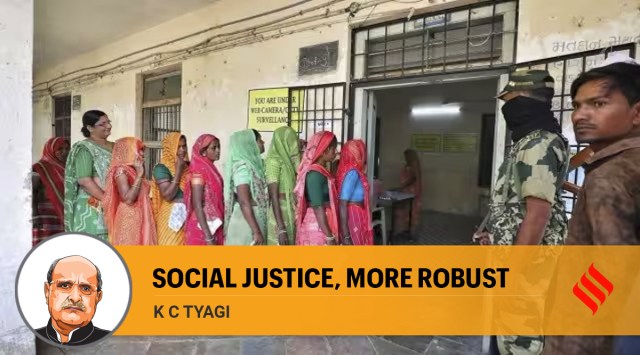
Bihar has created history under the chief ministership of Nitish Kumar by providing a fresh perspective on its social composition through the release of the 2022 caste-based survey. It was the government led by him that showed strong will and began the caste survey in the state. The results are there to see. After Independence, various political classes, ideologies and actors emerged, and reservation was enshrined in the Constitution to weaken the roots of the caste structure and for the upliftment of the deprived sections. However, this system applied only to Scheduled Castes and Scheduled Tribes at that time. A large section of the country, including castes with traditional occupations, such as artisans, weavers, fisherfolk, dancing and singing castes and gardening castes, were not under the reservation system. All these diverse groups provided services and goods and had minimal land ownership.
Even before the Mandal Commission, Karpoori Thakur in Bihar began the discussion around social justice by implementing the Mungeri Lal Commission report in 1977-78 in the form of an OBC reservation. With the publication of the 2022 caste survey, that process has been revived and reinvigorated. When Karpoori Thakur implemented the Mungeri Lal Commission report, he was abused and there were protests across Bihar. But he knew that social stratification was a part of India’s social structure and hence, one has to be prepared to tolerate opposition. He shook up the foundations of the system of stratification that had been in place for centuries. Nitish Kumar showed the same confidence and fulfilled the promise of the caste survey.
This survey data not only presents a detailed picture of caste demographics but also raises important questions about representation, social justice, and political strategies in Bihar and India as a whole.
Among the significant findings are the proportions of various caste groups, with Rajputs at 3.45 per cent, Yadavs at 14 per cent, Bhumihars at 2.86 per cent, Brahmins at 3.65 per cent, and Noniyas at 1.9 per cent. Among these are Backward Classes (27.13 per cent), Extremely Backward Classes (36.01 per cent), and general category (15.52 per cent). These numbers underscore the fact that caste continues to play a pivotal role in shaping Bihar’s social landscape. Additionally, the survey highlights the presence of marginalised communities in the state. Bihar’s population of Scheduled Castes stands at 3,54,63,936, while the Extremely Backward Classes account for 4,70,80,514 individuals. The Scheduled Tribes comprise 2,56,89,820 people, and the Mahadalits number 21,99,361. This distribution points to the persistent disparities and the need for targeted policies to uplift marginalised groups.
The religious composition data is equally noteworthy. Bihar’s religious demographics indicate that 82 per cent of its population identifies as Hindu, while 17.7 per cent follow Islam. Christianity, Buddhism, and other religions constitute smaller fractions. This mosaic of religious beliefs and practices underscores the state’s religious diversity and pluralism.
The caste-based survey data has several implications for the state’s sociopolitical landscape. First and foremost, it highlights the complex nature of caste identities. Political parties in Bihar have long relied on caste-based alliances and strategies to garner votes. With the fresh data, political equations may see adjustments as parties aim to woo specific groups. Parties will need to recalibrate their outreach and policies to cater to specific caste groups, potentially leading to new coalitions and realignments.
The significant numbers of SCs, EBCs, STs, and Mahadalits emphasise the urgent need for policies that promote social justice and economic empowerment. Political parties and policymakers will be pressured to address the unique challenges faced by these communities, including access to education, employment, and representation. Empowering these groups will contribute significantly to Bihar’s overall development. The data will pave the way for the central government to implement the recommendations of the Justice Rohini Commission. The Commission was tasked with recommending the correction of any repetitions, ambiguities, inconsistencies, and errors of spelling or transcription, examining the extent of inequitable distribution of benefits of reservation among the OBCs, and working out the mechanism, criteria, norms and parameters in a scientific approach, for sub-categorisation within such OBCs (quota within quota).
Beyond Bihar, the caste survey has far-reaching implications for Indian politics and society. As data becomes more granular, there is growing pressure to recalibrate reservation quotas to ensure equitable representation for marginalised communities (Jiski Jitni Sankhya Bhari, Uski Utni Hissedari). The findings will also influence national discourse on the need for a comprehensive caste survey at the pan-India level. According to the report, EBCs constitute 36 per cent of the population while currently they are being given 18 per cent reservation in jobs, while OBCs, at 27 per cent, are currently being given 12 per cent reservation. At present, there is a provision for 30 per cent for EBC and OBC together in Bihar, whereas according to caste-based calculation, their population is at 63 per cent.
With this figure, the question of reservation is going to become more urgent and there will be pressure to increase the percentage of reservation. Now, under the Karpoori formula in Bihar, Nitish Kumar’s formula will provide reservation to the extremely backward classes in proportion to their numbers. When Karpoori Thakur became the Chief Minister of Bihar for the second time in June 1977, out of the total reservation implemented in Bihar in 1978, he had earmarked 12 per cent for the “extremely backward” and 8 per cent reservation for the “backward”. This provision of reservation — quota within quota — is called the Karpoori formula, which has not been provided by any government in the last 75 years. This will be a historic step for the backward and extremely backward class people of Bihar.
While the data provides a comprehensive snapshot of caste identities, it is necessary to ensure that this information should be used constructively for targeted development rather than misused for identity-based politics.
The writer, a former MP, is National Spokesperson for the JD(U)